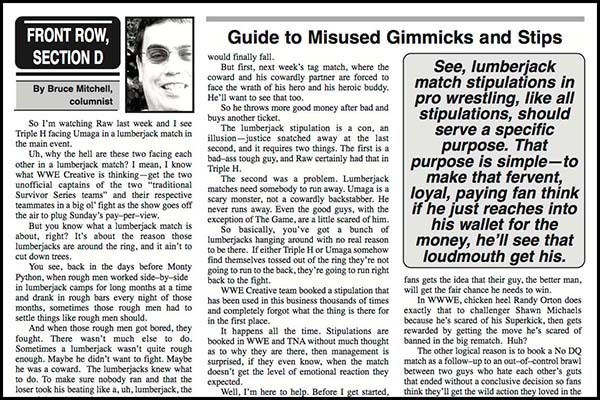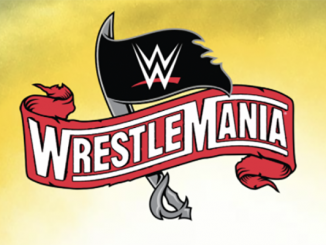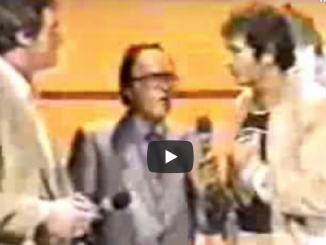
SPOTLIGHTED PODCAST ALERT (YOUR ARTICLE BEGINS A FEW INCHES DOWN)...
This month marks the 25th Anniversary of Bruce Mitchell becoming a Pro Wrestling Torch Newsletter columnist. No single person has influenced the editorial tone and direction of the Torch brand over the years than Bruce, who brought a hard-hitting, supremely well-informed, speak-truth-to-power approach to his writing. He went after sacred cows out of the gate, such as the beloved among “smart fans” (today’s “Internet fans” or “IWC,” I suppose) Eddie Gilbert and Jim Cornette. He also went hard after people in positions of authority and power who were abusing or misusing that power, or just not delivering a worthy product. He has also applauded and paid tribute to the greatest moments and movements in pro wrestling over the last 25 years, with a style of writing that has yet to be matched anywhere, I contend (despite Bill Simmons’s arrogant and uninformed contention last year that no one wrote at a high level about pro wrestling until his “Masked Man” columnist came along).
To celebrate and highlight Bruce’s stellar 25 years of influential and eloquent truth-telling about this fascinating industry, we’ll be featuring a single column from each of the last 25 years each of the first 25 days this month. His long-form columns were a pioneer approach to pro wrestling journalism, and the next 25 years you’ll experience a slice of what it is that has earned Bruce Mitchell widespread recognition within the industry over the years as being “Pro Wrestling’s Most Respected Columnist.” We began on Oct. 1st with his very first column, from Pro Wrestling Torch Newsletter #89 (cover dated Oct. 5, 1990).
Today we feature his column from the November 21, 2007 edition of the Pro Wrestling Torch Weekly Newsletter (#999) titled “Bruce Mitchell’s Guide To Misused Gimmick Matches and Stipulations,” among my favorites for reminding the wrestling industry of something that never should have been forgotten, which is how and why any gimmick match should take place.
NOTE: VIP members can access hundreds of Mitchell columns instantly in the BRUCE MITCHELL LIBRARY here, part of the massive unmatched online archives of insider wrestling coverage from over the past 28 years.
===
“Bruce Mitchell’s Guide To Misused Gimmick Matches and Stipulations”
Original Publish Date: November 21, 2007
Pro Wrestling Torch Newsletter #999
So I’m watching Raw last week and I see Triple H facing Umaga in a lumberjack match in the main event.
Uh, why the hell are these two facing each other in a lumberjack match? I mean, I know what WWE Creative is thinking – get the two unofficial captains of the two “traditional Survivor Series teams” and their respective teammates in a big ol’ fight as the show goes off the air to plug Sunday’s pay-per-view.
But you know what a lumberjack match is about, right? It’s about the reason those lumberjacks are around the ring, and it ain’t to cut down trees.
You see, back in the days before Monty Python, when rough men worked side-by-side
in lumberjack camps for long months at a time and drank in rough bars every night of those months, sometimes those rough men had to settle things like rough men should.
And when those rough men got bored, they fought. There wasn’t much else to do. Sometimes a lumberjack wasn’t quite rough enough. Maybe he didn’t want to fight. Maybe he was a coward. The lumberjacks knew what to do. To make sure nobody ran and that the loser took his beating like a, uh, lumberjack, the rest of those lumberjacks took their places in a circle around them. If, well, when the coward tried to run for it, the lumberjacks tossed him back in the circle. That’s how things were settled among the lumberjacks.
Or at least that’s how Dutch Savage or Stu Hart or Da Crusher or Johnny Weaver or Whitey Caldwell or Eddie Graham told the tale some long-ago night in some long-ago wrestling promotion. You see, this is the one we’ve been waiting for, this time we finally get a fair shot.
It doesn’t matter whether it was true, what matters was – could it lure the suckers in for one more week
…and set up the next?
See, lumberjack match stipulations in pro wrestling, like all stipulations, should serve a specific purpose. That purpose is simple, to make that fervent, loyal, paying fan think if he just reaches into his wallet for the money one more time for one more ticket for one more wrestling show he’ll finally get to see, once and for all, that loudmouth, yella belly backstabber get his at the hands on his tough guy hero.
So he pays his money and takes his seat, and damnit, just at that moment the coward is about to finally get stomped once and for all, another damn lumberjack jumps in and beats the crap out of his hero.
This creates mixed emotions in the heart of our fan. He paid good money for justice, for final resolution, for all the things that are now just generic names for generic pay-per-views, and he didn’t get it. But damn, he was so close, just one more show and surely the rat bastard would finally fall.
But first, next week’s tag match, where the coward and his cowardly partner are forced to face the wrath of his hero and his heroic buddy. He’ll want to see that too.
So he throws more good money after bad and buys another ticket.
The lumberjack stipulation is a con, an illusion – justice snatched away at the last second, and it requires two things. The first is a bad-ass tough guy, and Raw certainly had that in Triple H.
The second was a problem. Lumberjack matches need somebody to run away. Umaga is a scary monster, not a cowardly backstabber. He never runs away. Even the good guys, with the exception of The Game, are a little scared of him.
So basically, you’ve got a bunch of lumberjacks hanging around with no real reason to be there. If either Triple H or Umaga somehow find themselves tossed out of the ring they’re not going to run to the back, they’re going to run right back to the fight.
WWE Creative team booked a stipulation that has been used in this business thousands of times and completely forgot what the thing is there for in the first place.
It happens all the time. Stipulations are booked in WWE and TNA without much thought as to why they are there, then management is surprised, if they even know, when the match doesn’t get the level of emotional reaction they expected.
Well, I’m here to help. Before I get started, though, let me point out something to those I deliberately irritated with the Whitey Caldwell paragraph above, the ones who think the Outsiders were way back in the good old days – WWE and TNA have used every one of the stipulations in one way or another in this column in today’s pro wrestling, so they might has well have some idea what teey are for.
So let’s cover (some of) the rest:
The Triple Threat Match – One Guy vs. One Guy vs. One Guy: Originated at the creative height of ECW and featured Paul Heyman’s meticulous year-long booking of a championship feud between Shane Douglas, Terry Funk, and Sabu. Takes patience, time and an attention to detail to get real interest, heat, and revenue. You have to plot a course where the champion has two challengers who arrive at match-time at precisely the same place – the very precipice of the world championship. That’s not easy to do.
So, of course, a decade later it’s the three-man to ten-man graveyard for talented wrestlers to stall out and go nowhere – the refuse of the lazy booker who needs to accomplish three things – kill fifteen minutes or less of TV time, mollify talent desperate to appear on the show at any cost, and make sure no one is any more over after the match than when it began. Where cool moves go to die…
No DQ Match: Two logical reasons to book this. One is after the desperate champion deliberately kicks his opponent in the nuts just so he can leave the ring with his title belt since no titles change hands on a DQ in anything except real sports. He gets booked in no DQ match so fans gets the idea that their guy, the better man, will get the fair chance he needs to win.
In WWWE, chicken heel Randy Orton does exactly that to challenger Shawn Michaels because he’s scared of his Superkick, then gets rewarded by getting the move he’s scared of banned in the big rematch. Huh?
The other logical reason is to book a No DQ match as a follow-up to an out-of-control brawl between two guys who hate each other’s guts that ended without a conclusive decision so fans think they’ll get the wild action they loved in the first match – with the added bonus of a clear winner.
TNA usually books Abyss, Rhyno, or Raven in these things without the build-up as an excuse to bring out the gimmicks at least once a pay-per-view. Also, it allows one of them to throw another into that exact same place in the wall.
Battle Royal/Royal Rumble: You can tell which is which by this rule: Battle Royals come out of nowhere, everyone mills around, nothing much is at stake, and the finish is the good guy gets double-teamed by two bad guys and throws them both out anyway. The Royal Rumble is built up for months, the action is laid out carefully with a multitude of purposes, a WrestleMania title shot is at stake, and the finish is different every year.
Handicap Match: Perhaps the most misused gimmick in all of pro wrestling, usually instigated by the most overused gimmick in all of pro wrestling – the Heel General Manager. The Heel General Manager is mad at some wrestler who they wish was “Stone Cold” Steve Austin, but isn’t. To punish him, the GM books Not Stone Cold in a match with two!, no three!, no four opponents at once.
Not Stone Cold doesn’t act worried that he’s about to get the hell beat out of him, doesn’t get mad at thhe GM who put him in grave jeopardy, doesn’t face his inexorable fate with icy determination, and approaches this dangerous, unfair match exactly the same as he does any other. He gets the exact same amount of offense, does the exact same of selling, and get the exact same result he usually does in a normal match – unless he’s facing tag team wrestlers who are adept at using the strategies and rules of tag team wrestling.
Then he just beats the shitout of them.
Afterwards, management is surprised Not Stone Cold is not generating the same kind of excitement and drama Stone Cold did.
The Ladder Match (or any match involving too much climbing): There’s no real reason to ever have a ladder match. Ever heard anyone outside a pro wrestling promotion say “You think you’re tough? Stand on that ladder and fight me?” Still, Christian, Edge and The Hardyz can claim to be the kings of the ladder match, so they can be challenged for that status and taken down a peg if beaten. There’s also the advantage that ladder matches provide crazy action and are really, really dangerous. This is Awesome! This is Awesome!
Tables, Ladders, and Chairs match: Thankfully, WWE realized you can get the same effect with just the ladders.
Sixty Minute Time Limit/Iron Man Match: Used to be booked because the chicken champion kept stalling and walking around the ring until the time limit ran out so they could keep their title and if the hero just had a little more time he could catch him (sometimes paired with the old one, two, and the bell rings just before three).
Now it’s booked because the promotion has two wrestlers who can wrestle for sixty minutes and, unless, it’s Ring of honor, management has forgotten that fans don’t have the sstamina to watch much more than a twenty minute match
TNA Wrestler vs. X Division Wrestling vs. TNA Knock out: I have no idea how or why this would ever be booked, Mike Tenay’s assurances of “intrigue” aside.
The Cage Match: Call it whatever you want, put as many wrestlers as you want in thee thing – a Punjabi Prison Match, Hell In The Cell, or whatever name TNA came up with to imitate Hell In The Cell, Cage Of Death, War Games – it’s a cage match. The ring is surrounded by four walls of steel. It’s all about why those walls are there. Nobody but the wrestlers get in, nobody gets out – until everything is settled.
This should be the end of the months-long feud, after the lumberjack match and the no-DQ match and the Street Fight all ended with either outside interference or the heel cheating to win and getting caught after the match. After an emotional back and forth bloody battle, between two guys who hate each other guts, and with something at stake – a major title, a job with the company, or a head of hair – the good guy wins, period. Seen in this context, the cage match can be the most exciting thing in the sport. Every six matches or so, if the formula is followed in all the others, a company can pull the big screw (the most successful example being the Ric Flair vs. Kerry Von Erich cage match that set off the famous Freebird-Von Erich feud).
These days major companies wait all of one match before bringing out the cage or the Prison, whatever, the container, but sometimes the gimmick itself will sell a few buys among the newer, more gullible fans.
Neither WWE or TNA have the patience to build a personal feud over time very often, either, which is why you see two babyfaces like Batista and Undertaker who kind-of don’t like each other but really respect each other fighting in a cage. The audience’s loyalty is split between the two heroes and, worse, they really don’t want to see either guy lose. Edge gave a strong performance as the meanie screwing over the dead man, but it would have been much more effective with some nice, clean hatred fueling the match itself and WWE having the discipline to follow the six match rule above.
Ring of Honor did the strongest job in the modern era of getting the most out of the cage match gimmick with the epic ROH/CZW Cage of Death match that ended the months-long inter-promotional struggle between the two companies.
TNA believes in the cage match gimmick so much, and understands how to use it so little, that once a year they book an entire show of them. On the other hand, somehow UFC makes it work in every match on every single show.
===
END COLUMN
CHECK OUT PREVIOUS YEARS’ SELECTIONS OF BRUCE MITCHELL COLUMNS OVER THE LAST 25 YEARS: CLICK HERE




Leave a Reply
You must be logged in to post a comment.